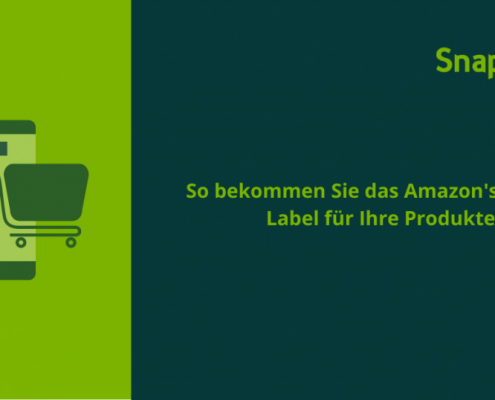Writing product texts: How to create the perfect product description

Writing product texts has to be learned. An ideal product description is more than simply reciting the features of an item: it provides information about the product, conveys the company’s own brand message, creates trust and encourages people to buy. To ensure that you succeed in balancing product information and sales magnets in your product texts, we present some basic rules for writing article descriptions in this article. We’ll also show you how to create engaging product pages using best practices.
3 basic rules for product copywriting that you should follow whenever possible
No less a figure than Joseph Pulitzer, namesake of the Pulitzer Prize, once said:
“No matter what you write – write briefly and they will read it, write clearly and they will understand it, write pictorially and they will retain it.”
Three basic rules can be derived from this quote that apply well to product copywriting. Two of them are universal, while the third depends a bit on your product and target audience.
#1: Keep it short
The abundance of offers in e-commerce is unmanageably large. From the customer’s point of view, this is one of the main reasons why online shopping is so attractive. For retailers, this means that you only get a small portion of the attention span of potential customers. This is even very low: As Mircosoft Canada claims to have found out in a study from 2015, it would be around 8 seconds – and thus below the level of a goldfish (source: t3n). Although the study has since been disputed by various sources and can no longer be found on the IT giant’s website, our attention span is unlikely to be much longer, as we are increasingly confronted with ads, banners, videos and the like in our everyday lives. This overload of stimuli is a drain on our concentration. In addition, we are developing an ever stronger inclination towards the “second screen”, i.e. a second screen that additionally occupies us, for example the smartphone that we handle while watching TV.
When shopping, and in other areas of life as well, we therefore want to have the essential information served up clearly and easily accessible so that we don’t waste so much of our scarce time. You should have this basic idea in mind when writing product texts. Prepare your information in such a way that your readers can grasp it quickly and limit yourself to the features that actually add value for them.
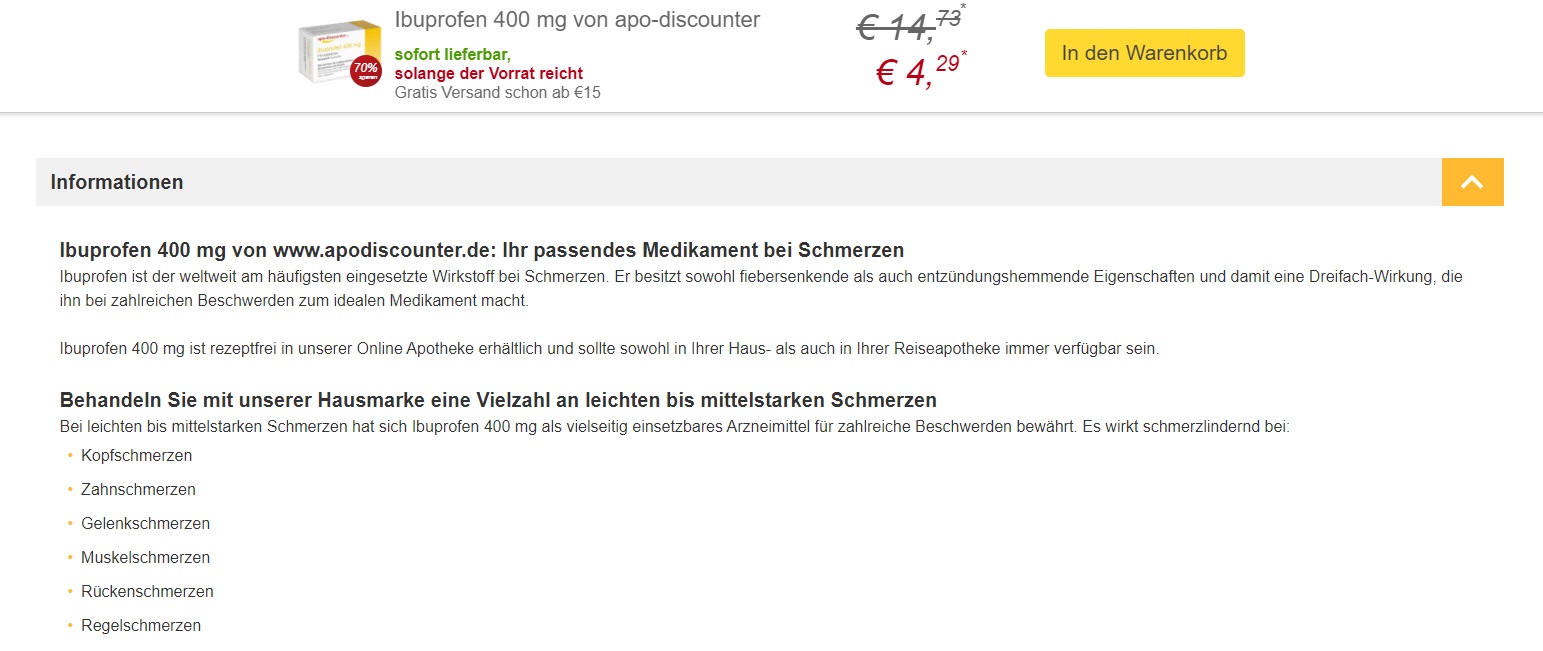
Source: apodiscounter.com
Apodiscounter is one of the most well-known online pharmacies in Germany and describes its products with concise texts.
#2: Use simple language
You don’t have to write a dissertation if you want to write a successful product text. On the contrary, the best item descriptions are easy to understand. This also has something to do with the fact that our attention span is so short that it simply does not allow for a second reading. For this reason, you should avoid technical terms and awkward phrasing and share your product information in a few (see point #1), short sentences.
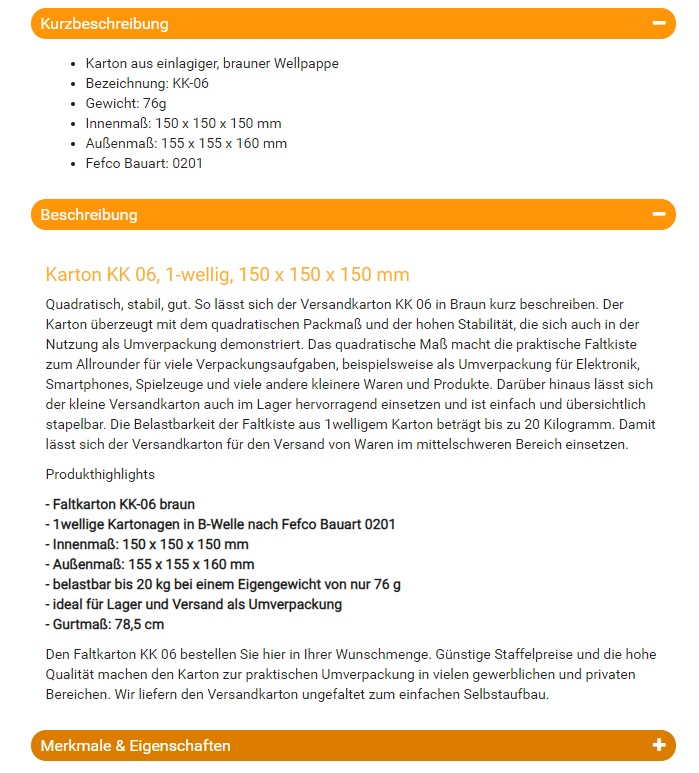
Source: Packaging
Verpacking sells packaging materials of all kinds – and focuses on a simple product description.
Also a good idea: the company packs additional information into so-called accordions that can be extended and retracted when clicked. Thus, no one is overwhelmed by too much text from the start, which corresponds well with our first point.
#3 Use language images
Language images can be the key to persuading customers who are still undecided to make a purchase. Again, this is not about you writing a product text that will earn you 15 points in any German exam. Your article description doesn’t have to be brimming with metaphors and other stylistic devices, but it can and should create a vision in the reader’s mind through meaningful language imagery. Stimulate your customers’ imagination and create an image of how your product will improve their lives. However, be sure to use rather subtle language. Exaggerations could be unserious and in the worst case deterrent.
As indicated elsewhere, this rule cannot be applied to all product groups. The above-mentioned Apodiscounter, for example, sells rather “sober” articles with medications that evoke little emotion and where primarily the facts, in this case ingredients and efficacy, are of interest. However, there are definitely categories where it can be worthwhile to get a little creative with the product text. This can be especially certain food, leisure, cosmetic or fashion items.

Source: YouFlake
YouFlake sells so-called flake squeezers and the matching self-made muesli in its own online store and on marketplaces. In the product text above, the retailer alludes to how its squeezer’s classy design makes it an eye-catcher in the kitchen.
Use ShopSpy and optimize your margin
In addition to successful product texts, it is above all the price that influences the purchase decisions of your customers. With ShopSpy, you can optimize your pricing for your online store and always be able to sell competitively.
SEO for product texts
Writing product texts always has something to do with search engine optimization, or SEO for short. For many store owners, this is a horror, as it requires quite a bit of time without any immediate visible effect. However, there are a few simple basic rules that you can use to increase your visibility in the long run and that you should therefore also take into account when creating article descriptions.
Research and use appropriate keywords
Keywords are terms that searchers enter in Google & Co. to get the matching web pages to their search intention displayed. The same thing happens with product searches. Since search algorithms are still text-based despite all the updates they have undergone over the last few years, relevant keywords are also essential for product copywriting.
It is best to think about which terms you want to be found with before you create your products. There are numerous tools for researching keywords. The most popular of them comes from Google itself: the Google Keyword Planner. In addition, there are numerous other providers, e.g.:
- Sistrix
- Ryte
- KWfinder
- Ahref
- Xovi
Unfortunately, none of them can be used completely free of charge, but the investment is worth it.
Tip: During keyword research, it has proven useful to choose a focus keyword, i.e. a term on which you mainly align your product texts SEO. In addition, you should sprinkle in other keywords that are relevant to the topic instead of relying on just that one term. This procedure is also called keyword clustering.
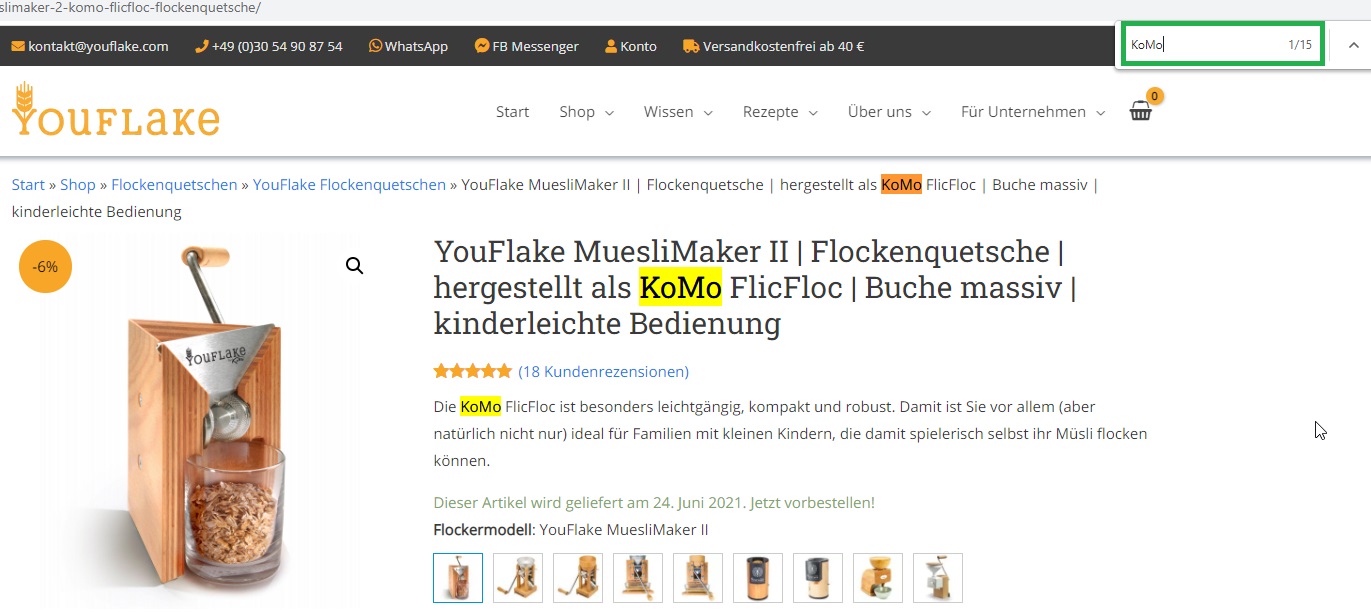
Source: Youflake
And we go to YouFlake once again. The trader seemed to be particularly concerned about the name of the manufacturer (KoMo) when creating the product text. Its name appears a total of 15 times – that’s really very often!
Create appropriate meta titles and descriptions
Many products are still searched for via search engines, first and foremost Google. Meta titles and descriptions are short paragraphs of text that refer to your products in the search engine results pages (SERPs). In a sense, they are the first thing searchers will see of your product, so you should take the time to write appealing meta titles and descriptions.
Ideally, these always contain their chosen focus keyword, which should be as far in front as possible. You should pay attention to the length of the text snippets. Previously, the maximum length for the meta title was 70 characters and for the meta description 160 characters. Today, this information is considered too inaccurate. Instead of counting characters, pixels are used for the specification. The maximum length for the meta title is 580 pixels and for the meta description 990 pixels. Both texts can be checked well on serpsim.com. But here, too, it should be said that the maximum length should best not be exhausted, so that definitely nothing is cut off. Some SEOs believe that especially short metas work well and recommend only a length of 550px for titles and 600px for descriptions. Since opinions vary widely here, you may want to experiment with different variations and monitor your CTR.
Reading tip: The so-called CTR is one of the most important KPIs in e-commerce. We’ll tell you everything you need to know about Amazon KPIs in this blog post.

Instead of a best case, here is a worst case: If meta title and/or description are too long, Google will cut them off.
Structure your texts carefully
Text structure is also a hard SEO factor. This also makes sense, because when it comes to selecting search ads, search engines behave much like companies that want to offer their customers (the searchers) the best possible user experience. Since it can be assumed that a well-structured text is easier to read and thus more user-friendly, you should attach importance to the structure of your article descriptions in your product page SEO. This includes a clear hierarchy of headings. It is best to define the title of your product as an H1 heading and make sure that there is only one H1 in the entire text. You should define subheadings as H2, H3 or H4 accordingly, this is probably as far as your heading hierarchy will go. For a string of facts and/or technical data, you can also choose bulleted lists, as these are particularly easy to grasp at a glance.
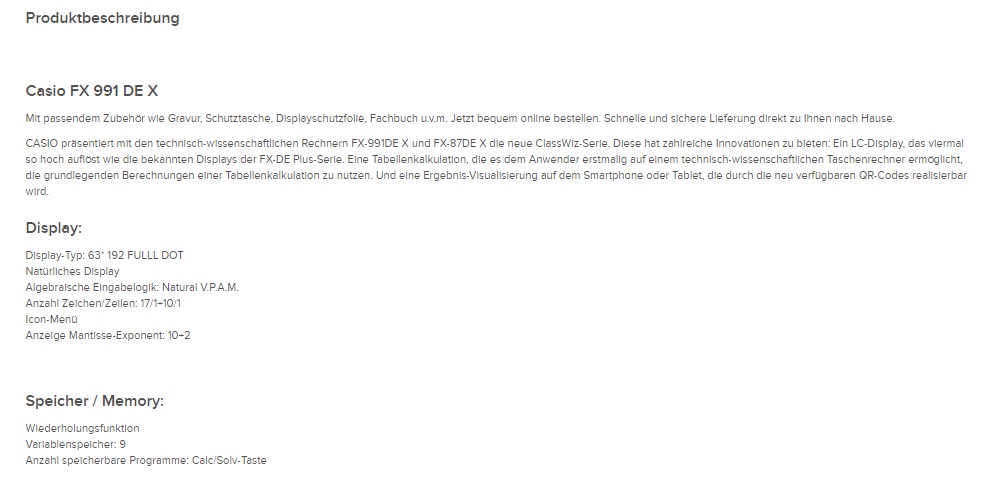
Source: CALCUSO
CALCUSO sells calculators and related accessories. In its product descriptions, the retailer pays particular attention to clarity.
Write unique content
In the end, a rule that is basically not only important from an SEO point of view. Write a unique product text! This is exactly not a (pure) SEO basic rule, because it is also valid detached from search engine optimization. If you place generic content in your store that already exists in exactly the same way a hundred times over, you will not be very successful with potential customers. In addition to sharing pure information, product copy should build trust, convey a brand message, and communicate value propositions. You can only achieve this with unique texts.
Nevertheless, the rule has a special meaning against the background of SEO, because duplicate content is usually penalized by search engines.
Tip: It can be very difficult to create unique text for each of your products, especially if you sell the same product in different versions. However, search algorithms are prepared for this case: They can assign so-called canonical tags and thus assign a page to the search engine crawlers, which they should prefer in the ranking in case of duplicate content. At best, these are your best-selling products.

Source: Miganeo
Here is a short excerpt from Miganeo’s source code. The merchant uses canonical tags to give prioritization instructions to search engine bots.
Conclusion
Writing product texts is not an entirely simple and time-consuming undertaking. The work pays off, however, as appealing product descriptions make you and your company stand out from the crowd of retailers, which has a direct impact on your sales. The following always applies: A good product text contains all important information, is short and formulated, search engine friendly and above all one thing: Unique!
Dynamic price adjustment with SnapTrade
Thanks to SnapTrade, you automatically adjust your prices whether you sell on Amazon, Ebay, or your own online store. Define a fixed price interval that guarantees you a safe margin and use different strategies for pricing.






